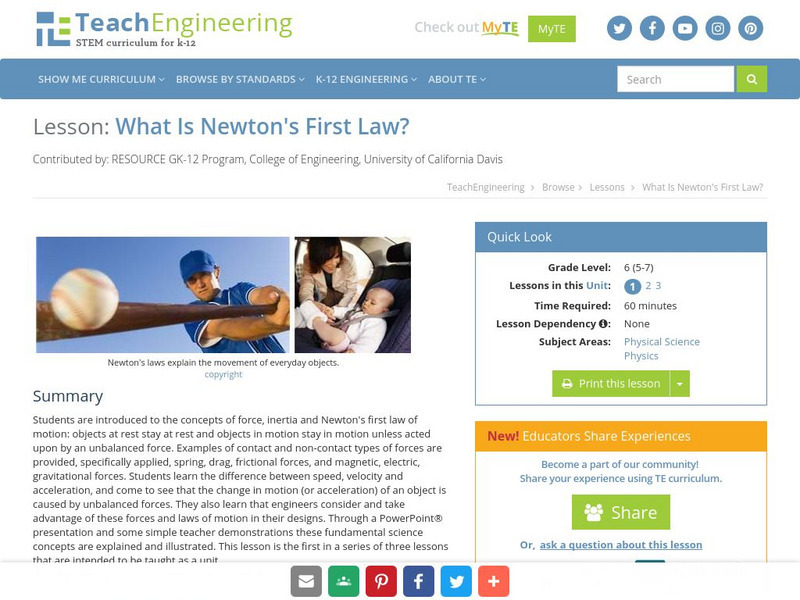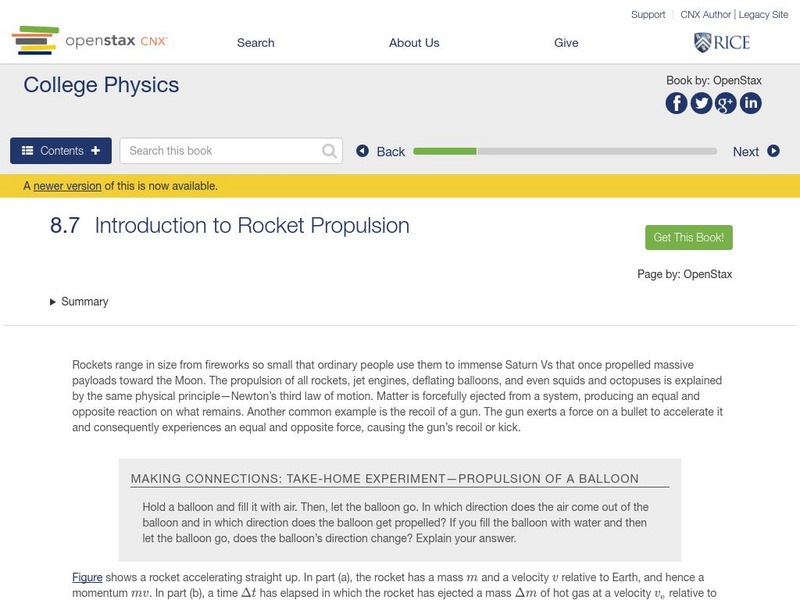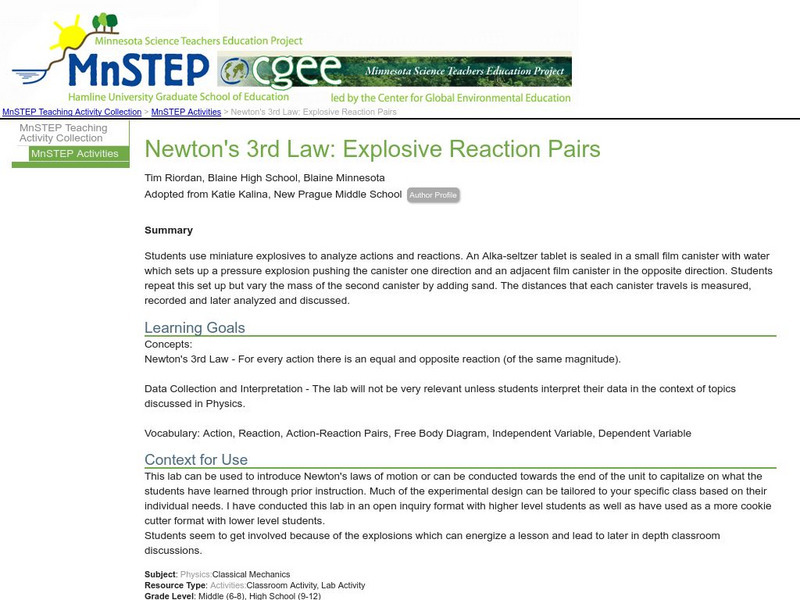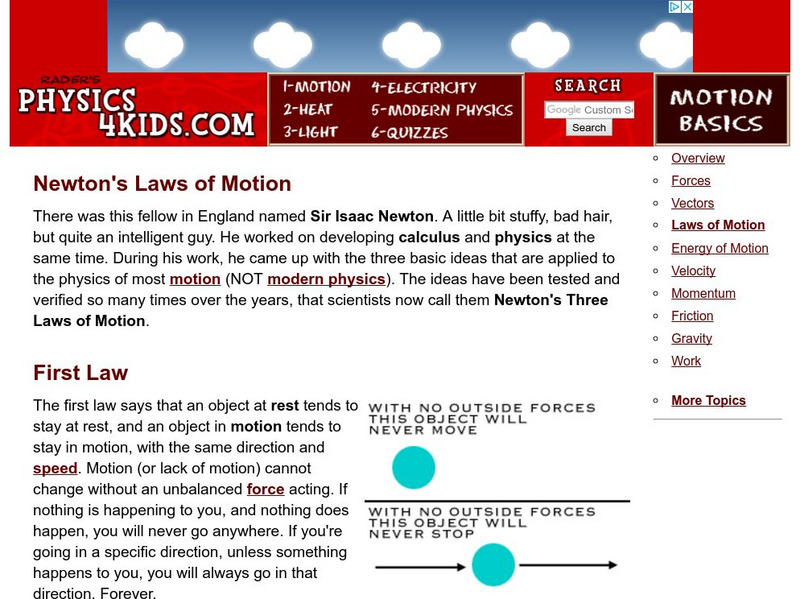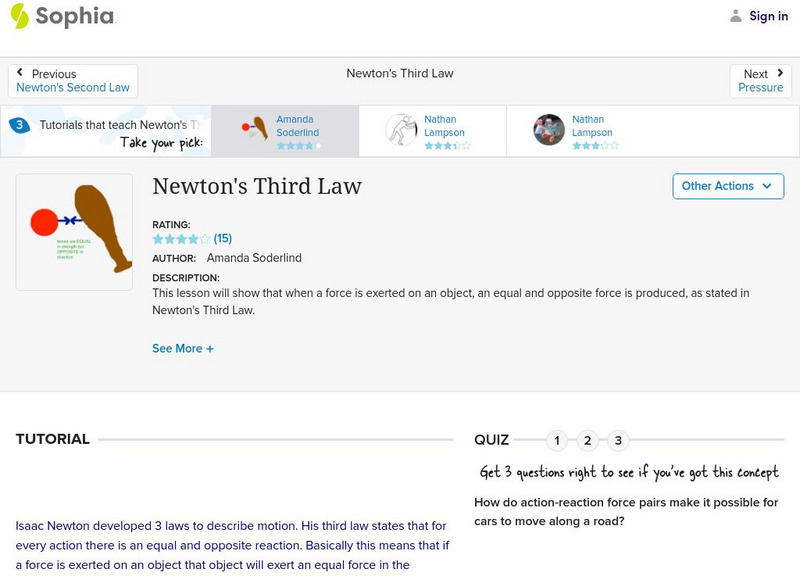Sophia Learning
Sophia: Newton's Third Law: Lesson 2
This lesson will show that when a force is exerted on an object, an equal and opposite force is produced, as stated in Newton's Third Law. It is 2 of 3 in the series titled "Newton's Third Law."
TeachEngineering
Teach Engineering: What Is Newton's First Law?
Students are introduced to the concepts of force, inertia, and Newton's first law of motion: objects at rest stay at rest and objects in motion stay in motion unless acted upon by an unbalanced force.This lesson is the first in a series...
TeachEngineering
Teach Engineering: What Are Newton's Laws?
Through a series of three lessons and one activity, students are introduced to inertia, forces, and Newton's three laws of motion.
Science and Mathematics Initiative for Learning Enhancement (SMILE)
Smile: Third Law of Motion
This Illinois Institute of Technology site is a lesson plan and lab that utilizes a toy rocket to investigate Newton's third law. Includes directions and practical applications.
Science Education Resource Center at Carleton College
Serc: Investigating Newton's 3rd Law: Coin Flick
In this elementary physics investigation, students explore Newton's 3rd Law of Motion: To every action there is an equal & opposite reaction. Pairs of students will line up 5 pennies, (touching each other), between 2 rulers. The row...
TeachEngineering
Teach Engineering: Rocket Me Into Space
One of the exciting challenges for engineers is the idea of exploration. This lesson looks more closely at Spaceman Rohan, Spacewoman Tess, their daughter Maya, and their challenges with getting to space, setting up satellites, and...
Georgia Department of Education
Ga Virtual Learning: Ap Physics 1: Newton's Laws of Motion
Newton's three laws are deceptively simple, but they are the underpinning of all of physics and govern the mechanics all of your actions in everyday life. Take an in-depth look at these laws in this learning module.
OpenStax
Open Stax: Introduction to Rocket Propulsion
From a chapter on Linear Momentum and Collisions in a Physics textbook. This section of the chapter discusses Newton's third law of motion in the context of rocket and jet engine propulsion. Students learn how to calculate a rocket's...
Texas Education Agency
Texas Gateway: Linear Momentum and Force: Introduction to Rocket Propulsion
By the end of this section, you will be able to state Newton's third law of motion, explain the principle involved in propulsion of rockets and jet engines, derive an expression for the acceleration of the rocket , discuss the factors...
Science and Mathematics Initiative for Learning Enhancement (SMILE)
Smile: Third Law of Motion
This Illinois Institute of Technology site provides a teacher lesson plan for an activity in which students use spring balances and carts to investigate the action-reaction relationship for any given force. Includes directions, materials...
TeachEngineering
Teach Engineering: Rocket Power
By making and testing simple balloon rockets, students acquire a basic understanding of Newton's third law of motion as it applies to rockets. Using balloons, string, straws and tape, they see how rockets are propelled by expelling...
BioEd Online
Bio Ed Online: Balloon Blast
In the following lesson students are asked to devise a plan to measure the distance of a balloon's flight, predict the direction a balloon will travel as it deflates, learn about Newton's Laws of Motion, experience Newton's Third Law,...
OpenStax
Open Stax: Satellites and Kepler's Laws: An Argument for Simplicity
In the following interactive students will begin to understand the laws of Kepler regarding planetary motion and derive the third law of Kepler for circular orbits. They will also discuss the Ptolemaic model of the universe.
University of Colorado
University of Colorado: Ph Et Interactive Simulations: Gravity Force Lab
An interactive simulation that teaches about gravitational force, Newton's Third Law, and force pairs by varying properties affect the gravitational force exerted between two objects. This simulation can either be downloaded or played...
Annenberg Foundation
Annenberg Learner: Amusement Park Physics: Roller Coaster
This interesting and interactive exhibit demonstrates how Newton's Laws of Motion impact the design and safety of roller coasters.
Open Curriculum
Open Curriculum: Analysis of Forces
This study information helps students apply Newton's third law and understand forces.
Texas Education Agency
Texas Gateway: Satellites and Kepler's Laws: An Argument for Simplicity
By the end of this section, you will be able to state Kepler's laws of planetary motion, derive Kepler's third law for circular orbits, and discuss the Ptolemaic model of the universe.
PBS
Pbs Learning Media: Aerodynamics: What Causes Lift?
How does an airplane stay aloft when upside down? This media-rich essay from the NOVA Web site offers an explanation based on Newton's third law of motion.
Other
Math Matters Every Day: Newton's Laws
Looks at how Newton's three laws of motion apply to an analysis of the forces being exerted when playing football.
Science Education Resource Center at Carleton College
Serc: Newton's 3rd Law: Explosive Reaction Pairs
This lab can be used to introduce Newton's 3rd Law of motion - For every action there is an equal and opposite reaction (of the same magnitude). In this exercise, students use miniature explosives to analyze actions and reactions.
Physics4kids
Physics4 kids.com: Newton's Laws of Motion
Get a brief overview of Newton's three laws of motion. Examples with diagrams are used to explain each law. An online quiz is available to test your understanding of these topics.
CK-12 Foundation
Ck 12: Physics Simulation: Third Law Simulation
This simulation explores changing forces to move a heavy cart to exact positions.
Sophia Learning
Sophia: Newton's Third Law: Lesson 3
This lesson will show that when a force is exerted on an object, an equal and opposite force is produced, as stated in Newton's Third Law. It is 3 of 3 in the series titled "Newton's Third Law."
Sophia Learning
Sophia: Newton's Third Law: Lesson 1
This lesson will show that when a force is exerted on an object, an equal and opposite force is produced, as stated in Newton's Third Law. It is 1 of 3 in the series titled "Newton's Third Law."

